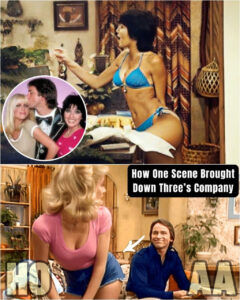
The Scandalous Scene That Doomed “Three’s Company” Off The Air: What Forced the Groundbreaking Sitcom to Vanish Overnight?
In the midst of a beloved sitcom’s success, a controversial scene sparks outrage and sets off a chain of events that forever changes the fate of Three’s Company. A bold move by Suzanne Somers for pay equality leads to tension, scandal, and a fractured cast. Behind the laughs and love triangles, lies a darker story of Hollywood’s power struggles, egos, and the toll it took on the stars.
As the show navigates its turbulent final years, secrets and betrayals unravel, leaving a lasting legacy that raises the question: how much of Three’s Company was truly scripted, and how much was reality?

At the height of its popularity in the late 1970s and early 1980s, Three’s Company was more than just a hit sitcom—it was a cultural phenomenon. With its cheeky humor, slapstick gags, and a premise that pushed the boundaries of what was acceptable on television, the show captivated millions of Americans. The story of a straight man pretending to be gay to share an apartment with two women, all to appease a prudish landlord, was revolutionary for its time. Yet, behind the laughter and lightheartedness, trouble was brewing—a combination of off-screen drama and one infamous on-screen moment that would ultimately contribute to the show’s quiet demise.
A Groundbreaking Beginning
When Three’s Company premiered on ABC in 1977, few could have predicted its impact. Adapted from the British series Man About the House, the show brought a new flavor to American TV—a blend of innuendo, farcical misunderstandings, and a trio of characters that quickly became household names. John Ritter’s Jack Tripper dazzled with physical comedy, Suzanne Somers’ Chrissy Snow became a pop culture icon, and Joyce DeWitt’s Janet Wood provided the perfect balance. The chemistry was electric, and by its third season, the show had climbed to the top of the Nielsen ratings.
The premise was both simple and scandalous: Jack, a culinary student, must pretend to be gay to move in with two single women. In the context of late-1970s America, this was daring, even subversive. The show’s humor, though sometimes labeled as “mindless fluff” by critics, resonated with audiences hungry for something different. It challenged gender roles and flirted with LGBTQ+ themes, all while delivering big laughs.

Behind the Scenes: The Salary Standoff
While the show’s suggestive humor and envelope-pushing scenes drew attention, the real drama was happening off camera. By the end of season four, Suzanne Somers had become a breakout star. However, she was earning just $30,000 per episode—far less than John Ritter’s $150,000. Supported by her husband and manager, Alan Hamel, Somers demanded equal pay and a share of the profits. In the early 1980s, this was almost unheard of for a female sitcom star.


